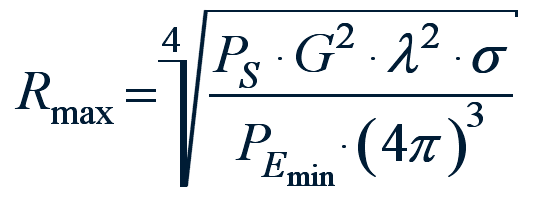The Radar Equation in Practice
Here are given some examples to demonstrate the consequences of changing selected parameters of Radar sets.
Transmitted Power
01.print.png)
01.png)
Not every transmitting vacuum tube is equally good. Minimal production tolerances can influence the obtainable transmit power and therefore also the theoretical attainable range.
Remember: the most important feature of this equation is the fourth-root dependence!
Other then the transmit power we assume all other factors are constant.
Calling all of them the coefficient k, so the maximum range equation becomes:
01.png)
Now it is easy to see that:
In order to double the range, the transmitted power would have to be increased by 16-fold!
In order to double the range, the transmitted power would have to be increased by 16-fold!
We can explain how such deviations change the maximum range values: if e.g. the transmitted power of the Russian Radar “Spoon Rest” is permitted to fluctuate from 160 kW to 250 kW will then the maximum range values be correct for distances between 250 to 270 km?
02.png)
02.print.png)
02.png)
From the relationship shown, we can state that 250km(160 kW)· 1,118 = 279.5 km(250 kW) so the maximum range value would be correct between 250 and 270 km!
In practice, results were reached between 180 kW and 240 kW since the transmitted power of the planar vacuum tube was frequency dependent.
03.png)
03.print.png)
03.png)
The inversion of this argument is also permissible: if the transmit power is reduced by 1/16 (e.g. failure into one of sixteen transmitter modules) then the change on the maximum range of the radar station is negligible in the practice < 2%.


Sensitivity of the Receiver
While evaluating the minimal received power we follow a different procedure:
It's also under the 4th root but in the denominator.
Well, a reduction of the minimal received power of the receiver gets an increase in the maximum range.
For every receiver, there is a certain receiving power as of which the receiver can work at all. This smallest workable received power is frequently often called MDS - Minimum Discernible Signal in radar technology. Typical radar values of the MDS echo lie in the range of -104 dBm to -110 dBm.
Antenna Gain
The antenna gain is squared under the 4th root (Remember: the same antenna is used during transmission and reception).
If one quadruples the antenna gain, it will double the maximum range.
Here is a concrete example from VHF- radar technology: Sometimes the P–12 (yagi antennae array: G = 69) was mounted at the antenna of the P-14 (same frequency, parabolic dish antenna: G = 900). This combination was often mentioned jocularly to “P–13”. In accordance with our radar equation the maximum range should increase:
04.png)
04.print.png)
04.png)
(Please note the fourth root was simplified against the square in the numerator and in the denominator at once.)
It would be beautiful if the maximum range could be tripled so simply.
But bigger antennas use much longer supply cables. Losses on the incoming feeding lines and losses
due to the misadjustment of the antenna give away half of what is invested.
Nevertheless: 1.6 times the maximum range isn't degraded either.
But there are more disturbances now: too many ambiguous targets
(overreaches).
